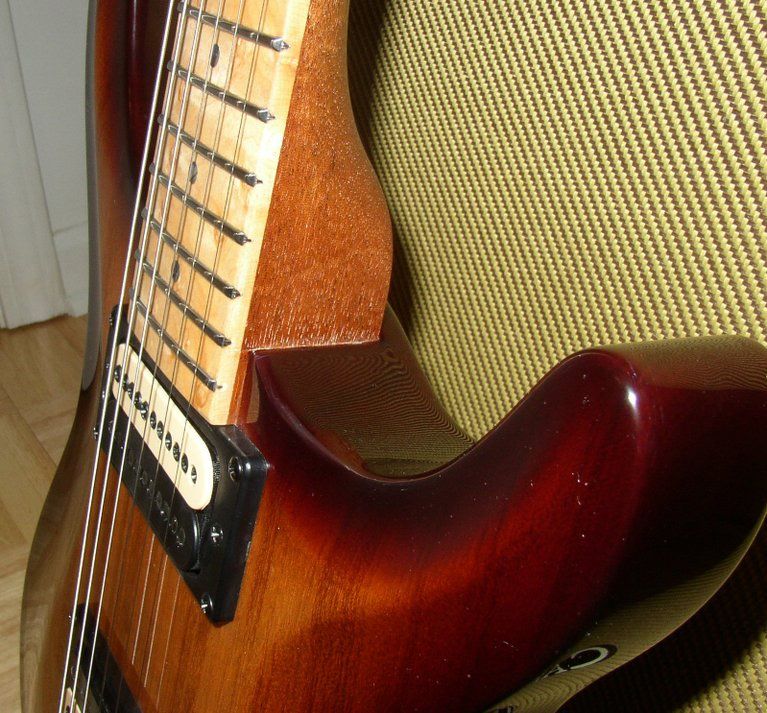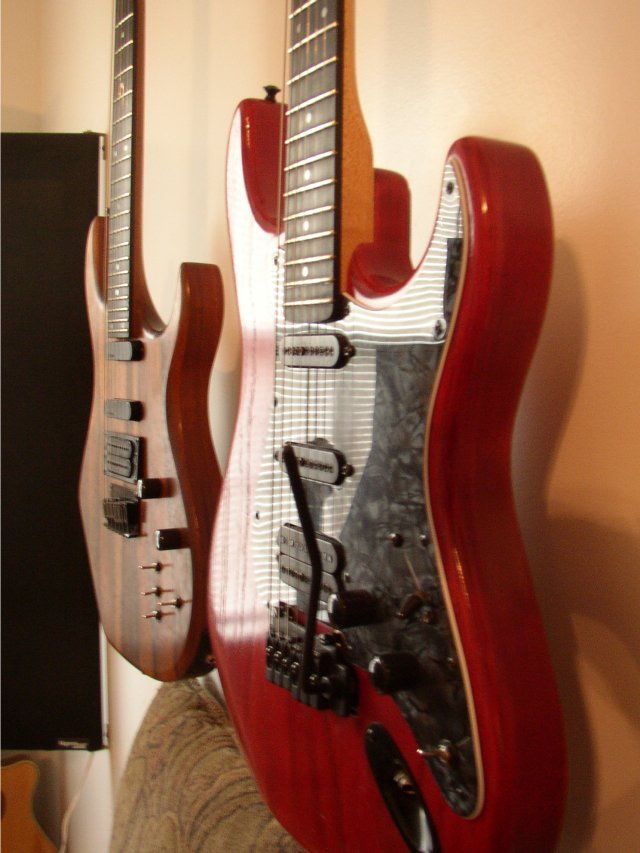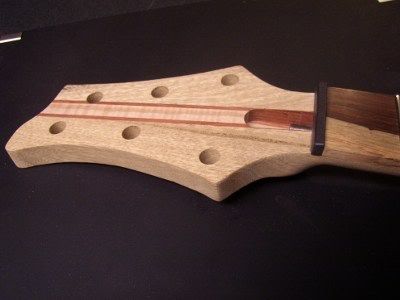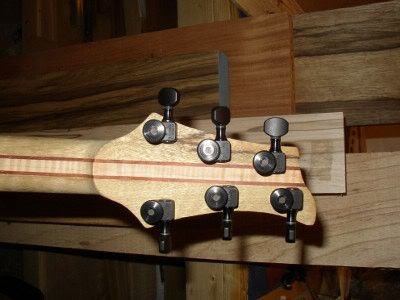-
Posts
1,546 -
Joined
-
Last visited
Content Type
Profiles
News and Information
Tutorials
Product Reviews
Supplier Listings
Articles
Guitar Of The Month
Links and Resources
Forums
Gallery
Downloads
Posts posted by Rick500
-
-
The length of the neck is determined by the scale length and where the end of the neck pocket lies in relation to the bridge.
For a 25.5" scale length, the breaking edge of the nut has to be 25.5" from where the strings contact the bridge saddles. Assuming the neck pocket is already cut, you should be able to find the distance from the end of the neck pocket to the nut.
-
Neck before oil and after one application of Tru-oil, wet-sanded with 600 grit sandpaper. The oil really brought out the flame in the maple and the color of the limba!


-
Welcome!
And I love the title of your post.

-
Interesting piece of wood. It'll be cool to see it with some finish on it to see what it does to the figure.
Do you know how you're finishing it yet? Looks like something that might do well with oil.
-
The first and most important thing to remember is that, unless you're moving the bridge, the scale length defines the distance from the nut to the bridge. 24" (old) or 25.5" (new) in your case. Nothing you can change there. The frets will fall where they fall and there's nothing you can do about it.
-
I don't know if any of the following will help, but I'll give it a go anyway.
21st fret of a 25.5" scale length will be a little more than 1.05" farther away from the nut than the 21st fret of a 24" scale length.
So given that with the new 25.5" scale, the nut has to be 1.5" farther away from the bridge than the old 24" scale, and assuming you're not moving the bridge, the 21st fret of the 25.5" scale will be about 0.45" farther away from the bridge (and pickups, etc.) than the 21st fret of the old 24" scale neck.
(I rounded...re-do the measurements, of course.)
-
Just draw a centerline on the headstock, and parallel lines however far out from the center line you need them.
-
Mahogany neck, sort of dark:

-
Feel free to post questions on things you've read that you don't understand...

-
No experience with any dyes or stains with Tru-oil, but I have used oil-based stain (tung-oil based stain...Woodburst, which is no longer manufactured) with tung oil finish. (See pics above.)
-
Therefore, we need pictures.

-
Yes, I have used tung oil finish on ash. I didn't grain fill, but that's because I wanted to texture of the ash to come through. If you want a smooth surface, you can grain fill before applying the tung oil finish.

-
There are limitless things you could tweak... body shape (make it a little more offset), horns (longer, shorter, different relative to each other), etc. etc. etc.
The thing that jumps out at me from your EBMM pic is the forearm contour. Maybe change the body shape a bit to make it your own, and use a similar forearm contour. Or incorporate similar contours into other parts of the guitar.
-
I've used both Tru-oil and "tung oil finish" (not pure tung oil, which would take practically forever to dry).
In my experience, Tru-oil builds up better than tung oil finish (I used Minwax Tung Oil Finish), and results in a slightly harder finish.
Tru-oil can be built up and buffed to a higher gloss.
If I wanted the texture/feel of the grain to come through best, I'd probably use a tung oil finish. For more gloss and a bit harder finish, Tru-oil.
-
Can you provide a little more detail on your wet sanding process?
How large of an area do you wet sand with 400? How wet do you keep the area you're working on? Do you use any method for pushing the slurry into the pores?
Thanks
-
Yeah, that was my initial thought as well.
Whether I can cut around it or not, depends on what I end up using the board for. It's just short of being wide enough to make one-piece bodies. I can rip it into two pieces--one 7" wide and one 4" wide, and get three body blank halves from the wide piece (I have a few other pieces I can make another body blank half from) and two neck blanks from the narrow piece; I'll have to do some creative layout with templates and see how I can maximize the yield without the check running into one of the body blank halves.
-
Mark a center line down the center of your body template, and align it with the center line of your body blank (convenient on your blank since there's a glue line).
Also mark a center line on all your other templates (pickup templates, trem cavity template) and align them with the center line on your body.
And careful with that padauk... padauk splinters are memorable.
-
Curious to know what you guys think about this:
I ordered a nice piece of black limba from my regular supplier, and when it arrived, I noticed there was a check about 3 inches from the edge, all the way through the thickness of the board, and about 10 inches down its length. It was a 48" x 10", 8/4 piece. Obviously, this is enough to call about a partial refund or exchange. (Which I did, and we worked out a more than fair arrangement, no problems.)
But I just got another piece from someone I've not ordered from before, 60" x 11", 8/4, and there's a check through the thickness of the board, right down the center, length of about 6". Would you call about that or just cut it off? I'm on the fence about it.
-
You can use a jigsaw, but stay well outside of the lines, as the jigsaw blade will not stay perfectly vertical.
Then use a router and your router template (both of which I assume you have...?) to clean it up.
You don't have to worry about the jigsaw not cutting a clean line -- you're not cutting anywhere near the line.
-
Good work! Congrats.
Love the black Baby Grand too.
-
Heh... Yeah, the best-laid plans, etc.
-
Couple update pics... Getting there!


-
Samick.
Edit: peanut butter chocolate chip, please!
-
btw, Google has a cool built-in exchange rate feature... just type something like one of the following into a Google search bar:
SEK to USD
1100 SEK to USD
...etc...



Sharkfin
in In Progress and Finished Work
Posted
Yes, plan is to scrape and then rough up the tenon a little with sandpaper. I wavered on whether or not to glue the neck in first and then finish, or finish first, and decided it to finish first.